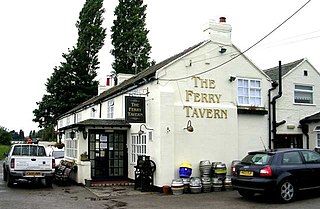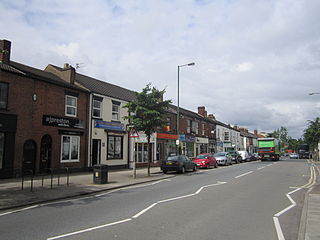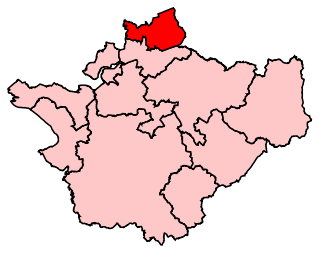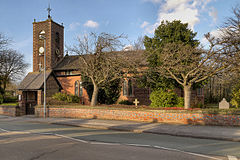Facilities
Burtonwood had four public houses. Three that have since been demolished are The Bridge House Inn, The Elm Tree Inn, and The Limerick Hotel. The Bridge House Inn and the Elm Tree Inn were both owned by the Marstons Group, and were demolished in 2014. The first was located in Phipps lane built in the early 1900s, the second was located on the corner of Phipps Lane and Chapel Lane, built around 1885. The Limerick Hotel was located on what was Cow Lane, now Burtonwood Rd, built in 1911 and demolished in the early 1940s because the pub was too close, to the (fully operational) Burtonwood Air Base and runway. The Village currently has only one public house, the Chapel House since the Fiddle i'th Bag Inn closed in the 2020s. It has three social clubs and three churches, St. Michael's, St. Paul of the Cross and the Methodist church.
The two primary schools are Burtonwood Community Primary School and St Paul of the Cross Primary School. The village does not have a secondary school or college and the nearest high school is Great Sankey High School, which has a sixth form attached to it. Also Hope Academy in nearby Newton-le-Willows and Priestley Sixth Form College in Warrington town centre is the nearest specialised sixth form college. [3]
Burtonwood village also has two doctors' surgeries, known as Burtonwood Surgery on Clay Lane, and Kinnock Park Surgery. There is also a large Co-operative store brand new since 2018 (Chapel Lane), as you walk into the village there is a fish and chip shop, a Village Barbers, a beauty salon and a Lloyd's chemist and a post office, located on Chapel Lane.
There are two recreational parks. Burtonwood also has three nature reserves. Wheatacre Woods (access via Clay Lane / Gorsey Lane), the Old Colliery Moss (access via Bold Lane / Back Lane) and an area known as the Burtonwood Nature Park which is accessed primarily from the footpath adjacent to the bowling greens behind Burtonwood Community Centre.
More information can be found on the Burtonwood Village history on the Burtonwood Village Facebook site.

Great Sankey is a civil parish in the Borough of Warrington, Cheshire, England. It is 2 miles (3.2 km) west of Warrington town centre and had a population of 24,211 in 2001 Census.

Winwick is a village and civil parish in the Borough of Warrington, Cheshire, England. Located within the historic boundaries of Lancashire, it is situated about three miles north of Warrington town centre, nearby is junction 22 of the M6 and Junction 9 of the M62. Winwick also borders Newton-le-Willows and Burtonwood.

Penketh is a civil parish and suburb of Warrington in the Borough of Warrington, Cheshire, England. It is located about 3 miles (4.8 km) west of Warrington town centre. It has a population of 8,699. It is in the historic county of Lancashire.

Newton-le-Willows is a market town in the Metropolitan Borough of St Helens, Merseyside, England. The population at the 2011 census was 22,114. Newton-le-Willows is on the eastern edge of St Helens, south of Wigan and north of Warrington.

Ashton-in-Makerfield is a market town in the Metropolitan Borough of Wigan, Greater Manchester, England, 4 miles (6.4 km) south of Wigan. As of the 2021 census, there was a population of 26,380.

Haydock is a village within the Metropolitan Borough of St Helens, in Merseyside, England. At the 2011 Census, it had a population of 11,416 Haydock's historic area covers the Haydock electoral ward and a section of the Blackbrook ward.

Orford is a suburb of Warrington, in the Warrington district, in the ceremonial county of Cheshire, England.

Warrington North is a parliamentary constituency represented in the House of Commons of the Parliament of the United Kingdom since 2019 by Charlotte Nichols of the Labour Party. It elects one Member of Parliament (MP) by the first past the post system of election.

Longton is a village and civil parish in the west of the borough of South Ribble, Lancashire, England. It is about 4 miles to the south west of Preston. The population of the civil parish, which also includes the village of New Longton, was 5,500 at the 2001 Census increasing to 7,652 at the 2011 Census.

Culcheth is a village in the civil parish of Culcheth and Glazebury, Cheshire, England, six miles (10 km) north-east of Warrington.

Docking is a village and ancient civil parish in the north-west of the English county of Norfolk. It is near the North Norfolk Coast Site of Special Scientific Interest.
Westbrook is a ward and suburb in north west Warrington, in the Warrington district, in the ceremonial county of Cheshire, England. Within the boundaries of the historic county of Lancashire, it forms part of the civil parish of Burtonwood and Westbrook, to part of which it gives its name. The main part of Westbrook was built in the early 1980s. There are new estates being developed, the newest (Chapelford) was started in 2001.
There are various modes of transport available in Warrington.

Ingoldmells is a coastal village, civil parish and resort in the East Lindsey district of Lincolnshire, England. It is situated on the A52, and 3 miles (5 km) north from the resort town of Skegness.

Woodbank is a village and former civil parish, now in the parish of Puddington, in the unitary authority of Cheshire West and Chester and the ceremonial county of Cheshire in northwest England. It is located on the Wirral Peninsula, about 6 miles northwest of the city of Chester and near the larger village of Saughall. In 2001 the parish had a population of 62.
Whittle Hall is housing estate within the parish of Great Sankey in the town of Warrington, in the Warrington district, in the ceremonial county of Cheshire, England. Its more exact location is in-between the old centre of Great Sankey, the new built Chapleford, and the Omega Development Site. The area falls under the WA5 postal code. The estate consisted originally of Whittle Hall Farm and its surrounding fields, however as part of the Warrington new town development, the last 20 years have seen the fields turned into modern houses. The estate also contains Whittle Hall Community Centre and the original farm building which are now due to be demolished for a proposed redevelopment. As the estate is part of the new town development, the people who reside there are originally from all over the UK.

The Borough of Warrington is a unitary authority area with borough status in the ceremonial county of Cheshire, England. The borough is centred around the town of Warrington, and extends out into outlying villages of Lymm and Great Sankey and the town of Birchwood.

Warrington is an industrial town in the borough of the same name in Cheshire, England. The town sits on the banks of the River Mersey and until 1974, was part of Lancashire. It is 19 miles (31 km) east of Liverpool, and 18 miles (29 km) west of Manchester.

The history of Warrington began when it was founded by the Romans at an important crossing place on the River Mersey. The Roman name for the settlement is not known but there is speculation that it could have been Veratinum which is listed as a Roman habitation in the area during the occupation period. A new settlement was established by the Saxon Wærings. By the Middle Ages, Warrington had emerged as a market town at the lowest bridging point of the river. A local tradition of textile and tool production dates from this time. The expansion and urbanisation of Warrington coincided with the Industrial Revolution, particularly after the Mersey was made navigable in the 18th century. Warrington became a manufacturing town and a centre of steel, textiles, brewing, tanning and chemical industries.


















